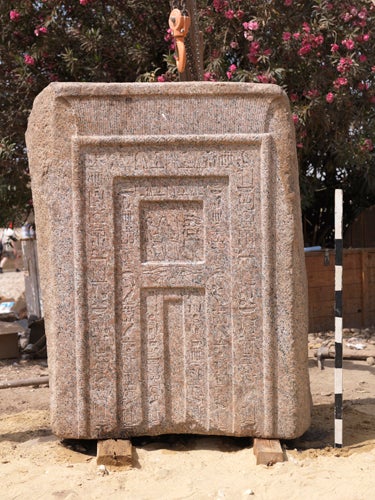An Egyptian excavation team has made a new discovery at Karnak during routine excavation works. A large red granite false door belonging to the tomb of Queen Hatshepsut’s vizier User and his wife Toy has been unearthed in front of the Karnak Temple.
Dr. Zahi Hawass, Secretary General of the Supreme Council of Antiquities, explained that the door is 175 cm tall, 100 cm wide and 50 cm thick. It is engraved with religious texts, as well as different titles of the vizier User, who took office at the time of the fifth year of Queen Hatshepsut’s reign, circa 1474 BC. The official's titles included mayor of the city, vizier, and prince. Hawass said that tomb number 61 on Luxor’s west bank belonged to User.
Mansour Boraik, the head of the Egyptian excavation mission, said that the newly discovered door was reused during the Roman period: it was removed from the tomb of User and used in the wall of a Roman structure previously found by the mission.
A chapel of User was also found at Gebel el-Silsila, a mountain quarry site at Aswan in use from the 18th Dynasty to Greco-Roman times. This attests to vizier User's importance during Pharaoh Hatshepsut’s reign, as well as to the importance of the post of vizier in ancient Egypt, especially during the 18th Dynasty. Mansour Boraik added that User is the uncle of the very well-known noble and official Rekhmire, who was King Tuthmosis III’s vizier and one of the most well-known viziers of the 18th Dynasty.
Other notable officials that served this New Kingdom Dynasty were Ramose and the military chief Horemheb, who later came to Egypt’s throne as the last king of the 18th Dynasty.
This announcement comes only weeks after the discovery of a colossal 18th Dynasty statue that depicts Thoth, the pharaonic deity of wisdom, as a baboon. The statue was discovered in four pieces in Luxor, where workers were reducing the ground water beneath Luxor in a bid to preserve the city's famous temples. Last month a 2.5m head of Amenhotep III - now assumed to be King Tut's grandfather - was unearthed in the Kom El-Hettan area of Luxor’s West Bank. Dr Hawass said, "It is a masterpiece of highly artistic quality and shows a portrait of the king with very fine youthful sculptured features," adding there were still traces of red paint on the head.
Colossal head from statue of King Tut's granddad found
Video: The Lost Tombs of Thebes – Inside the tomb of Rekhmire
Subscribe to Independent Premium to bookmark this article
Want to bookmark your favourite articles and stories to read or reference later? Start your Independent Premium subscription today.


Join our commenting forum
Join thought-provoking conversations, follow other Independent readers and see their replies